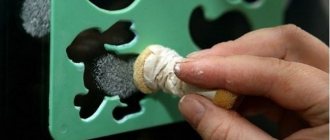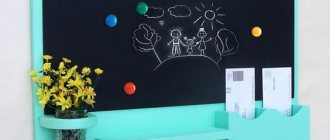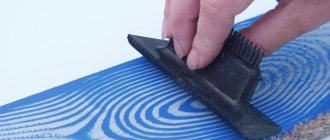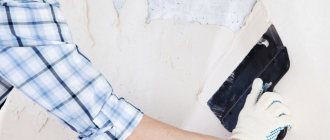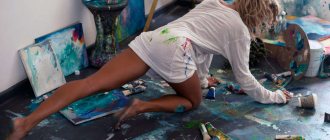How to prepare the surface?
Before applying stained glass paints to glass, mirrors or ceramics, the surface must be washed and degreased so that the paint adheres better, the adhesion to the glass is better, and... the stained glass paint does not peel off in the future.
Any detergent is suitable for washing. You can degrease it with alcohol or glass cleaner. The second option is used much more often, especially if the surface is large and flat.
You can degrease glass with glass cleaner.
Everyone knows that our skin secretes sebum, and on the palms of the hands and soles of the feet, it is produced especially intensively... By the way, this is why fingerprints are clearly visible on glass and metal. It is necessary to degrease the glass from sebum!
During operation, it is advisable not to touch the surface of the glass with your hands, so as not to leave fingerprints or palm prints. You can put, for example, a paper napkin under your hand. Very comfortably…
Expert recommendations for diluting dyes
To get the desired result and bring the picture to completion, you should follow a few simple recommendations from experts:
- Use only clean water for dilution; it must first be infused and filtered;
- When choosing a thinner, do not forget about the effects, otherwise the result will come as a surprise and lead to damage to the overall appearance of the painting;
- Dilution is carried out in small portions; it is necessary to test the diluent before the main work.
Dilution is carried out in small portions.
The paint for paintings by numbers has dried out, what should I do? Don't panic, she can be revived. The main thing is to act in stages and add the required amount of solvent. To prevent this from happening, you should always close the jar tightly, without leaving it open for a long time. It is better to work with a small amount of composition.
How to paint with stained glass paints on glass: pipette or brush?
The beauty of stained glass paints is that they can be applied not only with a brush, but also with a pipette, which depends on the base of the material and the height of the paint.
With a pipette, for example, it is convenient to fill large spaces, and then use a brush to distribute the paint over the surface. At least that's how I work... I got the hang of it and the work goes faster and more interesting! The surface is even, smooth, just like real colored glass! But mostly, stained glass artists work with a brush.
In the photo I am pouring paint with a special pipette, but you can take a regular pipette from the pharmacy
It all depends on the final result that you want to see at the end of the work. It’s up to you to decide whether to choose a brush or a pipette... In any case, you need to try both to understand what works best for you!
If you are a beginner, then it will be useful for you to know that stained glass paints come in different bases. And before you go to the store and make a choice, it would be nice to figure out what and how.
Storage recommendations
By following the storage tips below, you will never have problems with paint drying out:
- after use, be sure to tighten the lids of jars or tubes tightly, then double-check;
- make sure that there are no cracks or holes in the container where the coloring composition is stored; if there are any, it is better to move the paint to another container;
- store acrylic at room temperature, since in cold or hot conditions it tends to harden ahead of time;
- do not mix paints from different manufacturers, even if they are extremely similar in shades. Most likely, this combination will dry out very quickly.
Paints that are too dry, that have stood for a long time and have never been used, often freeze tightly. Therefore, it is better to avoid wasting time trying to dissolve them.
Tubes with acrylic paints Source aldopolidano.com
Is the circuit required or not?
Typically, classic painted stained glass or glass paintings have outlines. If your goal is beautiful, smooth murals, use raised paint or stained glass lead tape.
Remember: all contour lines must be closed. If there is a break somewhere in the outline, the colors will flow, mix, and this can ruin your work.
Most often they use a black outline or a tin color that imitates metal.
Unless, of course, this is a contourless technique, where the contour is not used to contain stained glass paint, but rather is of a decorative nature. In another article, you can read all about the most popular stained glass painting techniques
And of course, each manufacturer has its own contour paints in tubes of different colors. I especially like the ones that imitate silver or gold.
The golden outline looks great in subject paintings on glass
Be sure to let the relief outline dry for about 20 minutes before you start painting with stained glass paints! Take this into account! When working with stained glass paints, the sequence of actions one after another is important.
How to paint with stained glass paints?
Pouring paint and filling in the elements in stained glass painting is perhaps the most interesting part. You need to start filling each sector from the core, gradually painting the areas next to the outline. At the same time, it is not advisable to “climb” onto the contour itself, otherwise the painting will look sloppy and not so impressive.
You can start learning to paint with large flower buds
The background can be painted last. But there are other options for painted glass paintings, where the main background consists of acrylic paint and... newspaper! This decorative design of a glass picture looks harmonious in an ensemble with stained glass varnish paints!
Especially for lovers of stained glass painting, I develop and record Master classes in video format. One of these lessons may be suitable even for beginners, since it is “chewed” in detail and will be understandable to everyone. It is also ideal for those who want to enjoy a quiet lesson as Art Therapy for relaxation and calm.
Why dilute acrylic paints?
First of all, it should be clarified that the article describes the process of diluting the acrylic paints included with the paint-by-number set. Recently, such sets have become popular. They are chosen because of their convenience; there is no need to waste time searching for suitable coloring agents. And numbering helps to get a beautifully painted picture, which can then well complement the interior of the room, or it can be given to a loved one for a special occasion.
This is a way to show creativity, the process requires attention and helps to calm down, which is important after hard work days. However, having bought such a painting, you may be disappointed when you realize that the paints have dried out. The desire to run for a replacement (this is not always possible) or to look for a suitable option is unlikely to arise in such a case.
It's not always the developer's fault. Sometimes the artist himself does not close the jar tightly after work. In addition, the reason for the need to dilute acrylic paints is the desire to make a more beautiful coating. Coloring will be easier if the acrylic is diluted, it will eliminate the appearance of marks on the canvas from brushes, the borders will not stand out too much, the transitions will be smooth. Artists advise doing this.
As a result, a logical question arises: have the paints by numbers dried up, how can I dilute them? And this is one of the fastest ways to solve the problem. This will be discussed in detail below.
Painting will be easier if the acrylic is diluted and will eliminate the appearance of marks on the canvas from brushes.
How to correct defects and remove stained glass paints from glass?
A novice artist almost always encounters problems when working with stained glass paints: he accidentally “blurs out” more material, paints over the outline, creates bubbles... These defects need to be corrected immediately, before the paint dries.
Bubbles, for example, can be conveniently “expelled” to the contour, or “burst” with a needle or toothpick. And excess paint can be removed with a brush or cotton swab.
Paint that has leaked beyond the contour can be removed with a clean brush dipped in solvent.
It is convenient to clean an accidentally painted outline with a brush or stick dipped in solvent or water (depending on the base of the stained glass paint). Using a solvent can completely remove stained glass paints from glass before they dry.
Using water to dilute acrylic paint: proportions and features
If you decide to dilute acrylic with water, you should know what proportions and what results will be given. There are several dilution options. Water is added in the following quantities:
- 1 to 2, adding two parts of water will lead to the formation of a liquid consistency, and will be applied with smudges, the problem is solved by choosing a fluffy brush, several layers will have to be done;
- 1 to 1, you get optimal density, the layer will be bright. Painting is done in one layer;
- 1 to 5, a similar dilution is used to tint individual elements, the coating will be barely noticeable.
Modern acrylic paints supplied with paintings by numbers use a slightly different composition. Therefore, they are easy to wash and need to be diluted with a small amount of liquid. It should not exceed 10%.
The paints are easy to clean and need to be diluted with a small amount of liquid.
6.How to dilute stained glass paints if they have thickened?
Remember: if your working material has thickened, you can only dilute it with a special thinner, preferably from the same company as the paints! Why?
If you dilute water-based stained glass paints with water, they will fade after drying. The same thing happens with organic paints. White Spirit “kills” varnish-based paints.
The wrong thinner will impair adhesion to the surface, reduce UV resistance, gloss and original shade.
Purity and transparency of color are the main indicators of stained glass paints
To ensure that the finished painting does not fade or become cloudy, and that the paints do not change their composition and properties, use special thinners designed for these purposes! Every paint manufacturer has them!
Many stained glass works have been ruined when artists did not dilute thickened stained glass paints correctly.
Reanimating dried paint
With a hard piece you will have to work longer and more difficult. First of all, it must be converted into a powder state so that the particles become as small as possible. Afterwards they should be heated in a water bath; you can get by by adding boiling water. This can help produce paint that is acceptable for the job.
Sometimes they also resort to adding alcohol or nail polish remover. This is done if heating does not help. Work carefully, adding funds little by little.
Sometimes they also resort to adding alcohol or nail polish remover.
How to mix stained glass paints and get new shades?
Unfortunately, not all manufacturers of stained glass paints have such a large selection of paints as the French Pebeo Vitrail, for example. Don't despair, because paints can be mixed to get the desired shade!
To obtain new colors and shades, use a special container with indentations. Although you can get by with regular plastic bottle caps and other available containers.
Old cream jars make excellent containers for mixing paints.
Start mixing with a small amount of paint... it is important to remember that dark colors are easier to create than light colors. In any case, knowledge and skills come with practice. Try mixing and creating your own interesting colors and shades!
Where to mix acrylic paints
As mentioned earlier, it is recommended to prepare a small amount of coloring agent for coloring. For this reason, it is better to reanimate the dried composition not in the jar itself, where the entire volume is located, but in another container.
The reason is also the possibility of leaving the entire volume in a closed container, because adding a thinner can lead to the loss of the original properties and color brightness. Therefore, it is better for this purpose to choose a palette where you can adjust the components without rushing. Then it will be easier to obtain the required brightness.
For beautiful coloring, different levels of liquid consistency may be required (it will be used as a primer or first layer, or in places where shades transition). You may also need to mix several colors together to obtain a new shade.
Empty paint cans may be needed in the future to store the created shade in a closed container, so it's best to leave them.
For this purpose, it is better to choose a palette where you can adjust the components without rushing.
Why shouldn't you touch the surface of varnish-based paint?
If you have made your choice in favor of stained glass varnish paints , you need to remember one rule as an axiom: solvent-based stained glass paints take a long time to dry!
Any touch in the first 30-40 minutes will leave a fingerprint. Complete drying occurs after 8 hours or more (the manufacturer indicates the exact time on the jar). It is not recommended to force stained glass paints to dry, as this will cause them to lose their shine.
Also, keep your work to dry completely in a place where dust will not get in... otherwise you will end up with a “dusty decor” on the surface of the glass
